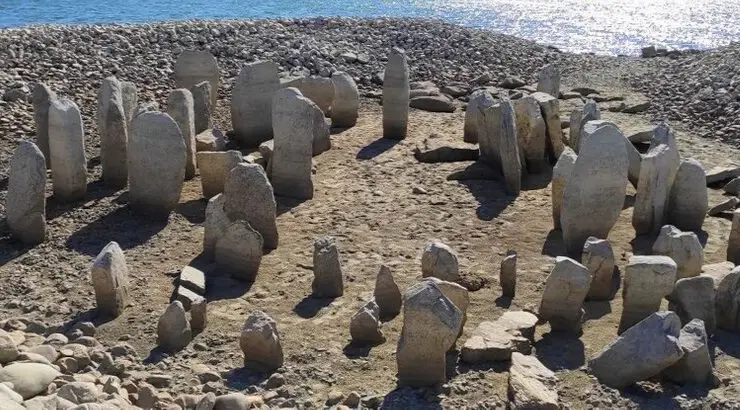Ancient History
Summer Drought Reveals 4,000-Year-Old ‘Spanish Stonehenge’
The “Spanish Stonehenge” may even predate the more famous Stonehenge.

(TMU) — A monument dubbed the “Spanish Stonehenge” has been uncovered following a summer drought, marking the first time that the megalithic structure has been fully visible in over 50 years.
Known as Dolmen de Guadalperal, the 7,000-year-old megalithic structure located in Spain’s Valdecañas Reservoir was rarely seen peeking out above water since it was submerged in 1963 when the reservoir was built.
The dolmen was first excavated in Spain’s Extremadura region lying east of the border with Portugal in the 1920s, but researchers didn’t publish any material on the site until the 1960s, according to Atlas Obscura. By then, however, the government of then-dictator Francisco Franco flooded the area to bring water and electricity to undeveloped parts of the country, submerging the archaeological site.
However, this past July, NASA satellites were able to pick up its location from space due to the record-breaking hot summer sweeping over Europe, and Spain in particular, which reduced the shoreline of the reservoir and dried the land surrounding the stone circle.
The so-called “treasure of Guadalperal,” which is comprised of roughly 150 stones, dates back to between 2,000 and 3,000 B.C. and is located in Peraleda de la Mata, a town of over 1,400 people that lies 105 miles away from Madrid.
The “Spanish Stonehenge” may even predate the more famous Stonehenge, which was built around 2,500 B.C. during the late Neolithic period.
NASA Observatory wrote on its website:
“Archeologists believe it was originally constructed as an enclosed space—a large stone house with a cap.
The dolmen could have served as a tomb, a site for religious rituals, or a trading hub since it was relatively easy to cross the river at this location.
The most recent recorded exploration and excavation of the site was by German archaeologist Hugo Obermaier in the 1920s. By the time Obermaier’s findings were published in the 1960s though, Valdecañas Reservoir was filled, submerging history with water.”
https://twitter.com/rontimes/status/1175843083545665541
IFLScience reports that Spain experienced temperatures that were far above average early in the summer which persisted into September. This past June was the third-driest month Spain has faced during this century.
The Dolmen de Guadalperal could likely be submerged yet again, according to LiveScience, as autumn and winter rains approach.
However, some local groups are petitioning to move the entire structure to higher ground so that it can be studied by researchers and visited by the general population. Yet some archaeologists fear that any attempt to move the entire monument—especially if done on such a tight deadline—could hasten the decay of the priceless structure.
By Elias Marat | Creative Commons | TheMindUnleashed.com
Typos, corrections and/or news tips? Email us at Contact@TheMindUnleashed.com
